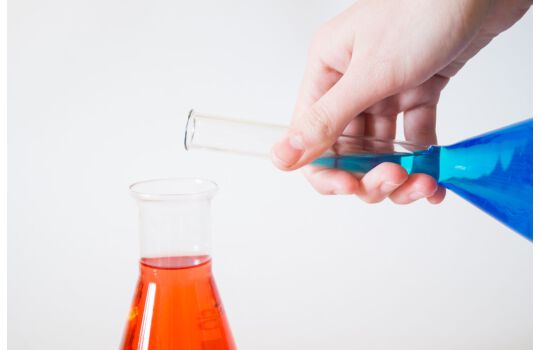Dimethylformamide is an organic compound with the formula (CH3)2NC(O)H. Commonly abbreviated as DMF (although this initialism is sometimes used for dimethylfuran, or dimethyl fumarate), this colourless liquid is miscible with water and the majority of organic liquids. DMF is a common solvent for chemical reactions. Dimethylformamide is odorless whereas technical grade or degraded samples often have a fishy smell due to impurity of dimethylamine. As its name indicates, it is a derivative of formamide, the amide of formic acid. DMF is a polar (hydrophilic) aprotic solvent with a high boiling point. It facilitates reactions that follow polar mechanisms, such as SN2 reactions.
Structure and properties
As for most amides, the spectroscopic evidence indicates partial double bond character for the C-N and C-O bonds. Thus, the infrared spectrum shows a C=O stretching frequency at only 1675 cm−1, whereas a ketone would absorb near 1700 cm−1.[5] The ambient temperature 1H NMR spectrum shows separate methyl signals, indicative of hindered rotation about the (O)C-N bond.
DMF is miscible with water.The vapour pressure at 20 °C is 3.5 hPa. A Henry's law constant of 7.47 × 10−5 hPa m3 mol−1 can be deduced from an experimentally determined equilibrium constant at 25 °C.The partition coefficient log POW is measured to −0.85.[9] Since the density of DMF (0.95 g cm−3 at 20 °C) is similar to that of water, significant flotation or stratification in surface waters in case of accidental losses is not expected.
Left: two resonance structures of DMF. Right: illustration highlighting delocalization.
Reactions
DMF is hydrolyzed by strong acids and bases, especially at elevated temperatures. With sodium hydroxide, DMF converts to formate and dimethylamine. DMF undergoes decarbonylation near its boiling point to give dimethylamine. Distillation is therefore conducted under reduced pressure at lower temperatures.
In one of its main uses in organic synthesis, DMF is a reagent in the Vilsmeier–Haack reaction, which is used to formylate aromatic compounds. The process involves initial conversion of DMF to a chloroiminium ion, [(CH3)2N=CH(Cl)]+, known as a Vilsmeier reagent,which attacks arenes.


